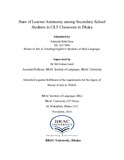| dc.contributor.advisor | Jamil, Dr Md. Golam | |
| dc.contributor.author | Onia, Fahmida Rifat | |
| dc.date.accessioned | 2017-07-18T04:07:49Z | |
| dc.date.available | 2017-07-18T04:07:49Z | |
| dc.date.copyright | 2016 | |
| dc.date.issued | 2016-11 | |
| dc.identifier.other | ID 14277004 | |
| dc.identifier.uri | http://hdl.handle.net/10361/8306 | |
| dc.description | This thesis report is submitted in partial fulfilment of the requirements for the degree of Masters of Arts in Teaching to Speakers of Other Languages, 2016. | en_US |
| dc.description | Cataloged from PDF version of Internship report. | |
| dc.description | Includes bibliographical references (page 47-48). | |
| dc.description.abstract | Learner autonomy engages the learners in effective decisions and various learning strategies through becoming aware in ELT classroom. As a result, learners’ communicative competence level increase and learners become more interested in varied learning strategies day by day in CLT classroom. Therefore, the aim of this research is to explore the present state of learner autonomy among secondary school students in English classes using communicative activities. Qualitative approach has been taken in this research. Four secondary English teachers and ten students have participated in interview session and six different classes have been observed for primary data collection. Therefore, data has been collected through the process of questionnaires, semi-structured interviews and class observations. In this research, literature review also has been presented as secondary source of data.
Autonomy is considered as the ability to control someone’s own learning. On the other hand, Communicative Language Teaching (CLT) approach creates communicative competence for language teaching and using language where real information will be changeable through four English skills. Therefore, it can be said that learners will be able to become self-motivated through communicative activities an autonomous atmosphere. In addition to, it can also be said that there is a connection between learner autonomy and CLT approach according to their nature.
This research actually reflects that there is a gap between secondary school teachers’ understanding regarding CLT approach and the following process of CLT approach in the classroom which is a major issue in this present situation. It also highlights that there is a distance between teachers and students in their communication system in English classroom which is not being helped implementing the principle of CLT approach and becoming autonomous learner. Finally, this report discusses the research questions based on the findings and data analysis to investigate the aim of this report purposefully. Brief summaries are also provided for recommendations and conclusion part. | en_US |
| dc.description.statementofresponsibility | Fahmida Rifat Onia | |
| dc.format.extent | 56 pages | |
| dc.language.iso | en | en_US |
| dc.publisher | BRAC University | en_US |
| dc.rights | BRAC University theses are protected by copyright. They may be viewed from this source for any purpose, but reproduction or distribution in any format is prohibited without written permission. | |
| dc.subject | Autonomy | en_US |
| dc.subject | CLT | en_US |
| dc.subject | Communicative activities | en_US |
| dc.subject | Communicative competence | en_US |
| dc.subject | English for today | en_US |
| dc.subject | Independence | en_US |
| dc.subject | Learning strategies | en_US |
| dc.subject | Secondary english curriculum | en_US |
| dc.title | State of learner autonomy among secondary school students in CLT classroom in Dhaka | en_US |
| dc.type | Thesis | en_US |
| dc.contributor.department | BRAC Institutes of Languages | |
| dc.description.degree | M. in TESOL | |

